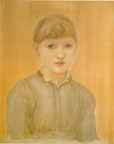 In A Portrait of Margaret Burne-Jones (1880s), Sir Edward Burne-Jones paints a lovingly innocent likeness of his daughter. The artist depicts Margaret so delicately that she almost fades into the background. Fine lines compose her face and figure, and her features nearly disappear from view. Her eyebrows are nearly imperciptible, and her nose and lips possess a fineness that causes them to blend in with the rest of her face. Margaret's hair, pulled back rather than flowing around her shoulders, along with the simple bangs across her forehead, enhance her image as an innocent girl. The color scheme is a palate of mostly neutral and earth tones, dominated by a light tan color. The girl is colored nearly the same hue as the background, causing her to fade even more. Margaret's simple bluish dress with modest ruffled collar complete this delicate portrait.
In A Portrait of Margaret Burne-Jones (1880s), Sir Edward Burne-Jones paints a lovingly innocent likeness of his daughter. The artist depicts Margaret so delicately that she almost fades into the background. Fine lines compose her face and figure, and her features nearly disappear from view. Her eyebrows are nearly imperciptible, and her nose and lips possess a fineness that causes them to blend in with the rest of her face. Margaret's hair, pulled back rather than flowing around her shoulders, along with the simple bangs across her forehead, enhance her image as an innocent girl. The color scheme is a palate of mostly neutral and earth tones, dominated by a light tan color. The girl is colored nearly the same hue as the background, causing her to fade even more. Margaret's simple bluish dress with modest ruffled collar complete this delicate portrait.
Common to many PRB portraits, the eyes serve as the focal point of the painting. Burne-Jones paints the eyes with slightly darker shade of blue than the dress, and he uses black paint to color the pupils and to rim the irises and eyelids. Margaret clamly looks toward the viewer from her traditional portraiture posture.
Compared to other work of Burne-Jones, this piece is mild and not as striking, both in color and composition. Yet, a pureness in emotion emerges from this depiction of his daughter, and this intensity of feeling matches that of his other pieces.
Questions
1. Burne-Jones was inspired by his affair with Maria Zambaco, and used her influence to paint some of his most powerful pieces. The strong use of color and line in his pieces shows the intensity of romantic love he experienced. However, Burne-Jones was also influenced by a different type of love later in his life: the love of his daughter, Margaret. Burne-Jones and his daughter formed a very close relationship. The artist so admired his daughter that he said, in a letter to Charles Eliot Norton, "I praise her to her face that she may be used to flattery and be sick of it, and not astonished or touched when it is used by others." This pure love comes through the artist's depiction of Margaret. What visual methods in the painting show this emotion? How does the simplistic style of the painting express the artist's devotion to his subject? How does this painting compare visually and emotionally to his earlier paintings driven by romantic love?
2. In many PRB paintings, such as Rossetti's Ecce Ancilla Domini, the artists illustrate the innocence of their female subjects by painting them with averted eyes and turned head. These women do not look straight ahead. When artists want to develop a sense of defiance or the lack of timidity or modesty, they paint their subjects with a confontational gaze. An example of this is Millais' Portrait of a Girl (Sophie Gray). Compare Millais' portrait with Burne-Jones' Margaret. Both pieces feature a girl with a direct gaze. Yet, the tone of each work differs. How so, and what visual elements cause this to happen? How can the gaze of Margaret be interpreted? How does the gaze continue to express the loving relationship between father and daughter?
3. Bill Waters says that "It was often commented upon by his contemporaries that Burne-Jones did not have the skills required to make a portrait painter." What elements in Margaret support this claim? Are there any qualities that refute this opinion? Overall, does Burne-Jones possess skills in portraiture equal to those of his PRB associates?
Bibliography
Waters, Bill. Burne-Jones -- A Quest for Love: Works by Sir Edward Burne-Jones Bt and Related Works by Contemporary Artists. London: Peter Nahum, 1993.
Last modified 27 October 2004